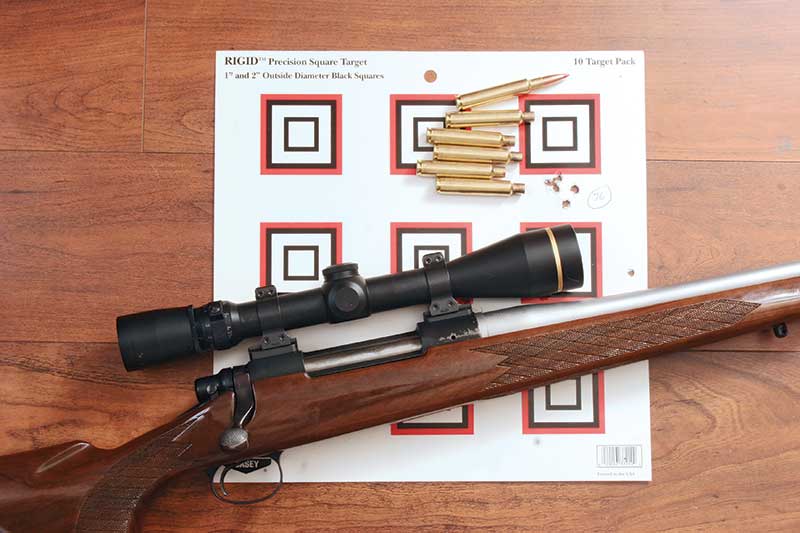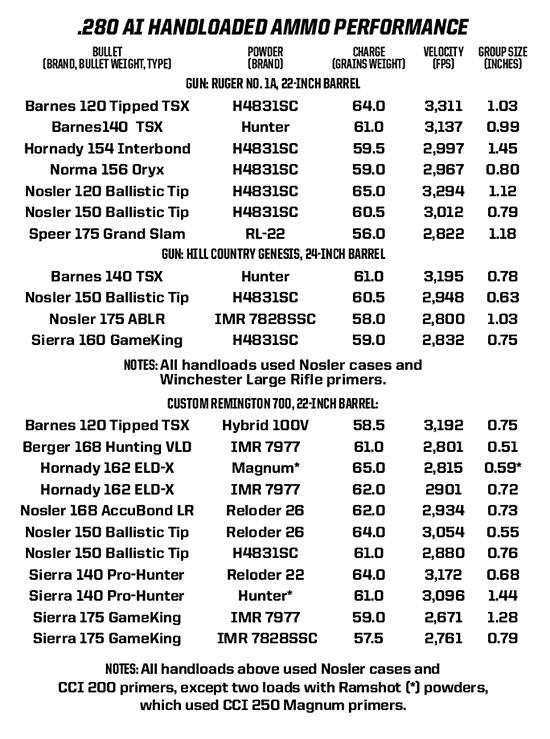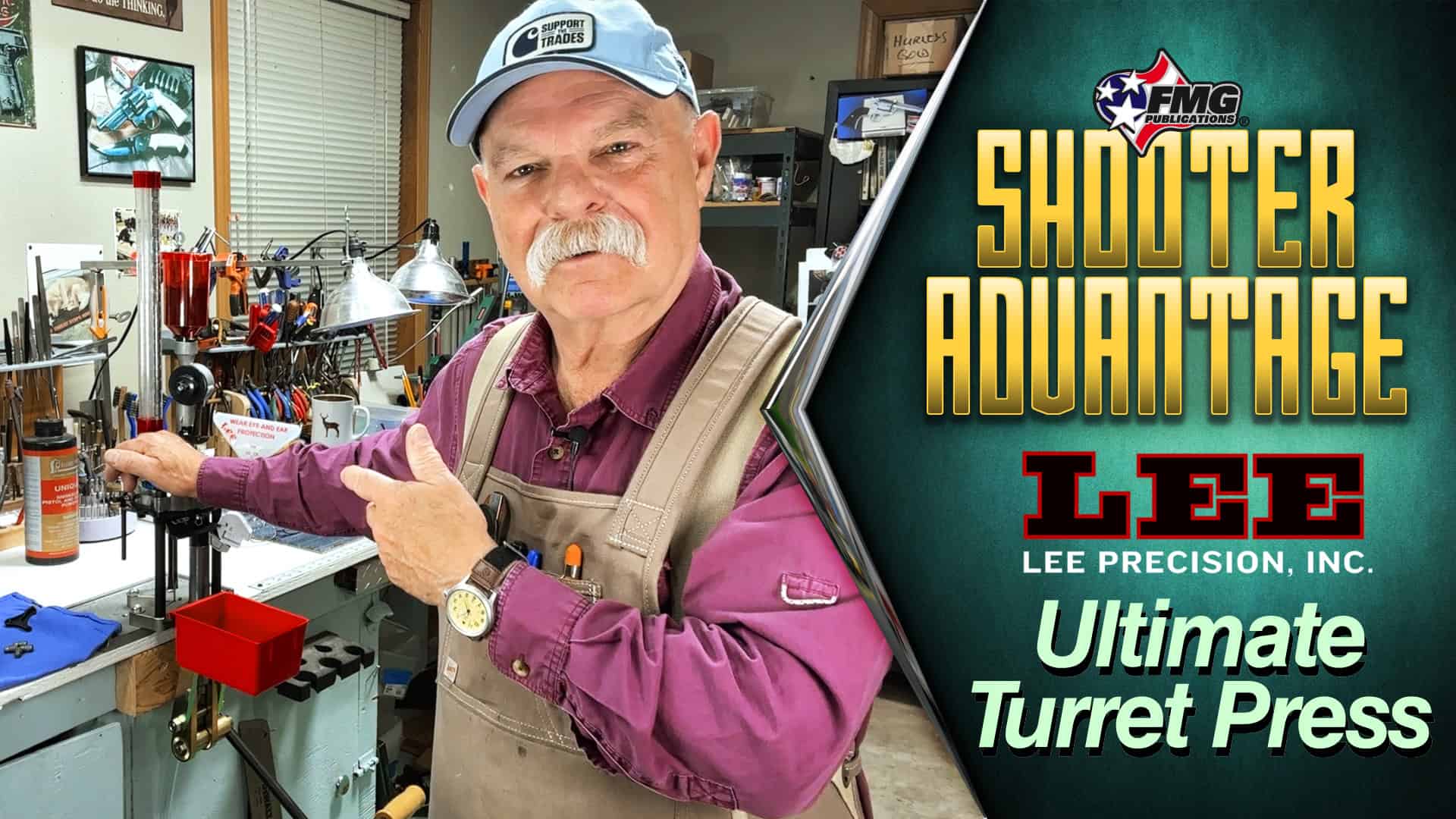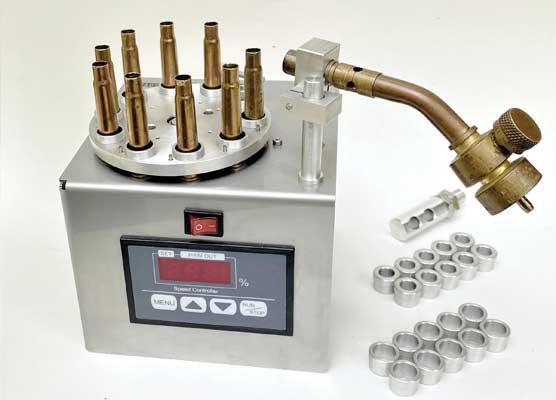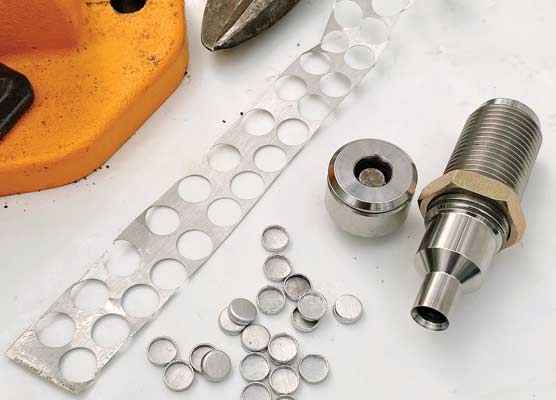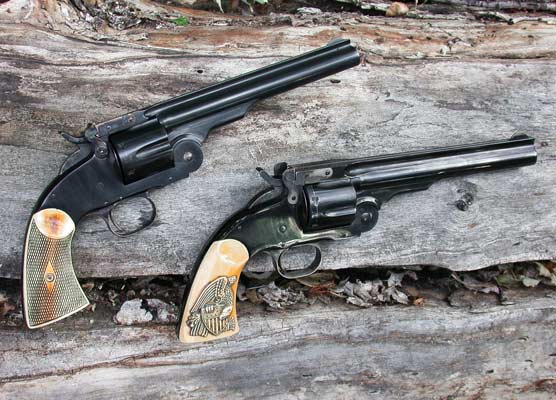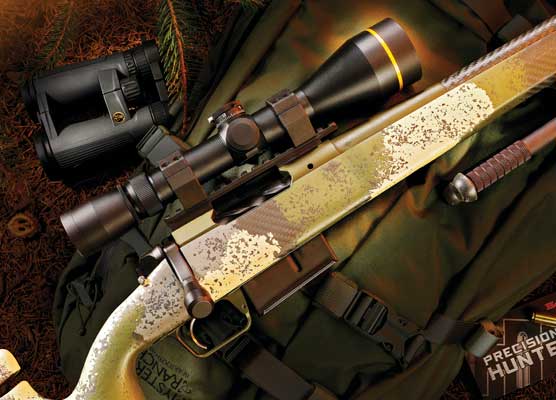Promise Delivered
The .280 Remington Ackley
Improved Lives Up To Its Reputation

John used his first .280 Remington Ackley Improved (above), a rechambered Ruger No. 1A,
to take this Wyoming pronghorn with a Nosler 140-grain Ballistic Tip factory load at 344 yards.
The Douglas barrel on John’s latest " .280 AI was threaded and chambered by the late Mickey
Coleman, well-known accuracy gunsmith from Alabama. This was the rifle’s very first 5-shot
group at 100 yards, measuring slightly over 3/4 inch.
Some credit 1917’s 7×64 Brenneke with being the first factory 7mm/06, but shortly before World War I Winchester developed basically the same cartridge for a new bolt-action hunting rifle they planned to introduce in the US and Europe. The war interrupted Winchester’s plans and afterward they introduced the .270 Winchester in a somewhat different bolt rifle named the Model 54. Consequently a commercial 7mm/06 didn’t appear in the United States until 1957, when Remington introduced their .280, moving the shoulder forward slightly to prevent chambering .280 ammo in .270 rifles.
Some “millennial” shooters might assume the .280 appeared to take advantage of the higher ballistic coefficients of some 7mm bullets. Instead Remington wanted to approximate .270 Winchester velocities at lower pressure, since they intended to chamber the .280 in their Model 740 autoloader and 760 pump. In fact the original .280 factory load designed to compete with 130-grain .270 ammo used a 125-grain bullet with a pretty pitiful ballistic coefficient (BC).
The .280 didn’t impress most hunters, partly because the 740 was already chambered in .30-06 and the 760 in .270, but did excite rifle loonies, whose dreams are often constructed around ballistic trivia. Back then hunters still debated whether the .270 Winchester or .30-06 was best, but .280 fans noted their choice was the perfect compromise, because 7mm spitzers could approximate either 130-grain .270 or 180-grain .30-06 loads.
The .280 appeared during the post-WWII wildcatting era, when half the gunsmiths in America thought they could come up with a better cartridge than any factory round, so the .280 was instantly “improved” by blowing out the shoulder. In 1962 famous Utah gunsmith and writer P.O. Ackley published his book Handbook for Shooters and Reloaders, and its long list of cartridges included the .280 Remington Ackley Improved, with P.O.’s signature 40-degree shoulder. The notes included reloading data “from the R.C.B.S. Company, obtained in their new modern laboratory.” No barrel length was specified, but the velocities listed were pretty zippy, with a 140-grain bullet at 3,320 feet per second and a 175 at 2,850, “plainly demonstrating there is little advantage in using a belted magnum case, for anything under .30 caliber.”
This claim has been made ever since, one reason the .280 AI was frequently chambered in custom rifles, but it remained a wildcat until 2008, when Nosler turned it into a factory round. Their loading manual’s pressure-tested data comes pretty close to the old RCBS numbers. The fastest 140-grain load gets 3,265 fps and the fastest 175-grain 2,828 fps.
Velocity Champion?
Perhaps even more impressive is the top load with 160-grain bullets, often chosen as the optimum 7mm bullet weight by hunters, listed at 3,045 fps—about 100 fps faster than the standard SAAMI muzzle velocity for 160’s in the 7mm Remington Magnum, a cartridge with over 20 percent more powder room than the .280 AI. This ballistic magic is accomplished in two ways: SAAMI data is shot in 24-inch barrels rather than 26-inch barrels, and the SAAMI maximum average pressure (MAP) for the 7mm Remington Magnum is 61,000 PSI.
When the .280 AI was accepted by SAAMI, its MAP was set at 65,000 PSI, the same as the .270 Winchester’s. The 7mm Remington Magnum’s is comparatively low because it sometimes shows wider pressure variations with some bullets and powders. These normally aren’t seen by handloaders, but can be detected with electronic pressure equipment and SAAMI prefers to play it safe.
However, 3,045 fps with a 160-grain bullet is far below the velocities obtained with some other 7mm magnums, whether belted or not. The 160-grain One 7mm “magnum” that doesn’t is the 7mm Remington Short Action Ultra Magnum, for an excellent reason: Its powder capacity is just about exactly the same as the .280 AI’s. Given this similarity, I thought the 7mm SAUM would be far more popular, but apparently lovers of ballistic minutiae are often conventional in their choice of bolt actions. The 7mm SAUM operates best with a custom magazine, both to feed cartridges reliably and accommodate today’s high-BC 7mm bullets. The .280 AI works just fine in any of the zillions of actions accommodating the .30-06, and many—such as the popular Remington 700—provide plenty of magazine room for long bullets.
Neither of the .280 AI’s I’ve owned has been limited by magazine length. The first was a Ruger No. 1B single-shot, originally in 7×57 Mauser and rechambered by the gunsmithing department of Capital Sports & Western Wear in Helena, Montana. It shot well but eventually went down the road and a couple of years ago I replaced it with a rifle put together on a Remington 700 action, with a 22-inch Douglas barrel chambered by the late “accuracy” gunsmith Mickey Coleman. During the interval between the Ruger and Remington I also tried several handloads in a 24-inch barreled .280 AI borrowed from Hill Country Rifles.
Now, many older shooters would consider the 22-inch barrels of my pair of .280 AI’s way too short, since muzzle velocities are around 50 or 100 fps less than possible in “proper” 24- to 26-inch barrels. But one reality of the 21st-century trend toward high-BC hunting bullets is slightly less muzzle velocity doesn’t matter much. Such bullets retain far more velocity than conventional hunting spitzers, and make up the initial “loss” of 100 fps within 200 yards. This makes considerable sense, because smaller cartridges recoil less than magnums, and barrel life is longer. But ever since the appearance of smokeless powder the primary emphasis has been on muzzle velocity, partly because extra zip sells, even though we normally don’t use high-velocity cartridges to shoot big game animals at ranges close enough to powder-burn their hides. factory loads for the 7mm Weatherby Magnum and .28 Nosler run 100 to 200 fps faster and yes, I’ve verified those numbers from 26-inch factory rifles. But both those cartridges also recoil a lot more than the .280 AI.
Some of the listed loads aren’t found in any “official” source, mostly because there is still very little pressure-tested .280 AI data. Hornady, Nosler and Hodgdon are about it, so some of my data was worked up with the help of computer programs such as QuickLoad and basic ballistic knowledge. One simple fact is despite its smaller caliber, the .280 AI should safely match .30-06 muzzle velocities with the same bullet weights, because of about 6 percent more powder room and 5,000 more PSI.
In the 700 I really wanted to try Alliant’s Reloder 26, because it adds at least 100 fps to .270 Winchester velocities with 150-grain bullets. In my own 22-inch barreled .270, for instance, Alliant’s published data produces right around 3,000 fps with 150-grain Nosler Partitions. Given the similarity between the .270 and the .280 AI, RL-26 seemed like a logical choice for 150- to 168-grain bullets.
None of this load work-up involved the long-time wildcatter’s technique of adding powder until cases showed signs of distress, then backing the charge down “a little.” Instead, I worked up to a velocity that according to computers, published data and experience indicated might be a reasonable velocity, and stopped. All worked fine, with no signs of excessive pressure, but as always use caution in your rifle.
